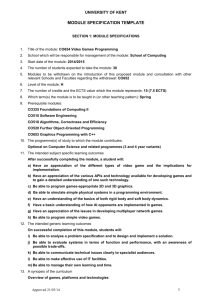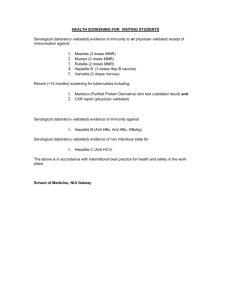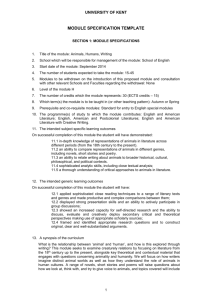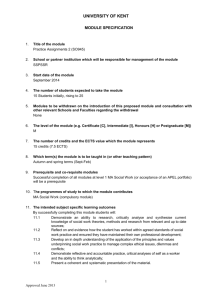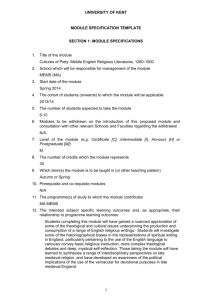S1 2012 CHCFC508A - Aesthetic & creative
advertisement
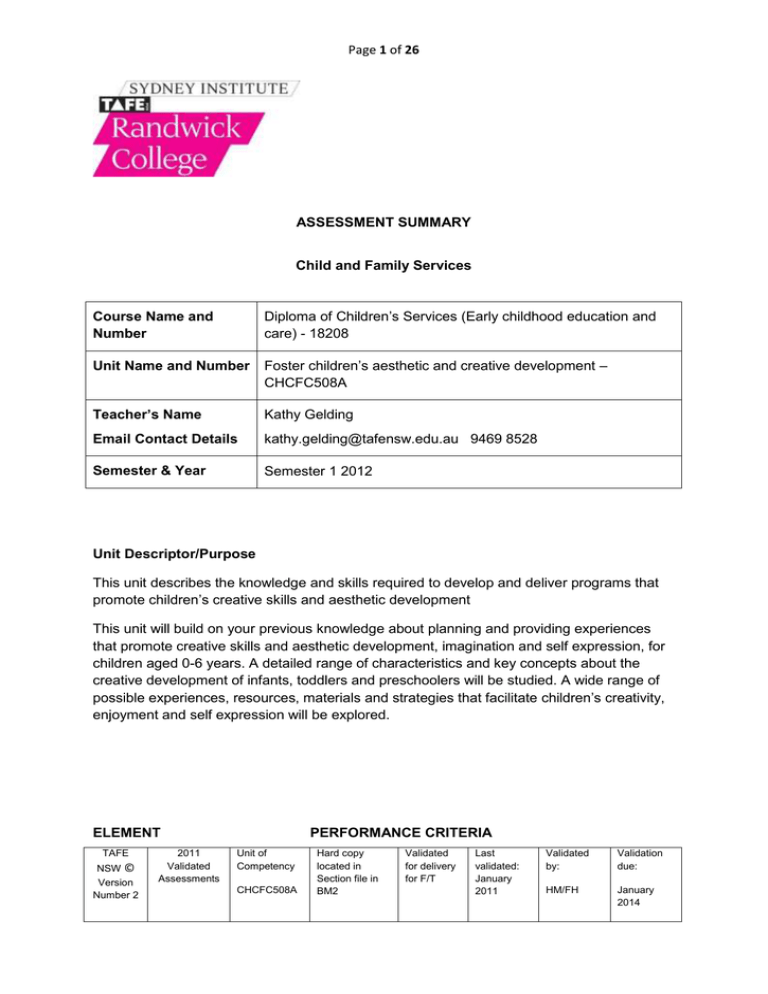
Page 1 of 26 ASSESSMENT SUMMARY Child and Family Services Course Name and Number Diploma of Children’s Services (Early childhood education and care) - 18208 Unit Name and Number Foster children’s aesthetic and creative development – CHCFC508A Teacher’s Name Kathy Gelding Email Contact Details kathy.gelding@tafensw.edu.au 9469 8528 Semester & Year Semester 1 2012 Unit Descriptor/Purpose This unit describes the knowledge and skills required to develop and deliver programs that promote children’s creative skills and aesthetic development This unit will build on your previous knowledge about planning and providing experiences that promote creative skills and aesthetic development, imagination and self expression, for children aged 0-6 years. A detailed range of characteristics and key concepts about the creative development of infants, toddlers and preschoolers will be studied. A wide range of possible experiences, resources, materials and strategies that facilitate children’s creativity, enjoyment and self expression will be explored. ELEMENT TAFE NSW © Version Number 2 2011 Validated Assessments PERFORMANCE CRITERIA Unit of Competency CHCFC508A Hard copy located in Section file in BM2 Validated for delivery for F/T Last validated: January 2011 Validated by: Validation due: HM/FH January 2014 Page 2 of 26 Elements define the essential outcomes of a unit of competency. The Performance Criteria specify the level of performance required to demonstrate achievement of the Element. Terms in italics are elaborated in the Range Statement. 1. Plan and provide aesthetic experiences for children 1.1 1.2 1.3 1.4 1.5 1.6 1.7 2. Provide developmentally appropriate dramatic and imaginative play experience for children 2.1 2.2 2.3 2.4 2.5 TAFE NSW © Version Number 2 2011 Validated Assessments Unit of Competency CHCFC508A Identify and select a range of developmentally appropriate visual, musical and other sensory stimuli to provide children with experiences of art and beauty Select appropriate materials and present them attractively Provide work and play areas promoting aesthetic qualities for both children and adults Formulate strategies for fostering creative development and aesthetic awareness in children Respond to children’s interests that arise spontaneously as they participate in aesthetic experiences Design program of aesthetic experiences in response to emerging skills, abilities and interests of individual children and groups of children Present aesthetic experiences that encourage appreciation of diversity including cultural diversity Present play areas both indoors and outdoors which provide children with opportunities to enjoy dramatic and imaginative play Plan/design developmentally appropriate experiences to stimulate children’s involvement Provide inviting, stimulating and safe experiences for individual children and small groups of children involved in imitative, dramatic and imaginative play Provide adult support through facilitation and extension of children’s imitative, dramatic and imaginative play experiences Present play areas which are culturally rich and reflect the diversity of families using the service Hard copy located in Section file in BM2 Validated for delivery for F/T Last validated: January 2011 Validated by: Validation due: HM/FH January 2014 Page 3 of 26 ELEMENT PERFORMANCE CRITERIA Elements define the essential outcomes of a unit of competency. The Performance Criteria specify the level of performance required to demonstrate achievement of the Element. Terms in italics are elaborated in the Range Statement. 3. Support children to participate in the expressive arts 3.1 3.2 Encourage children to talk about their creations Share enthusiasm for creative work with children 3.3 Encourage children to respect and appreciate the creative work of peers 3.4 Provide children with opportunities to discuss and explore artwork, design and/or images 4.1 Provide a variety of experiences to stimulate children’s awareness and develop their creativity, imagination and self expression through play Provide materials and experiences that stimulate different senses and promote body awareness Recognise, acknowledge, encourage and follow up children’s enthusiasm and curiosity 4. Provide a variety of experiences to develop children’s creativity, imagination and self expression 4.2 4.3 TAFE NSW © Version Number 2 2011 Validated Assessments Unit of Competency CHCFC508A Hard copy located in Section file in BM2 Validated for delivery for F/T Last validated: January 2011 Validated by: Validation due: HM/FH January 2014 Page 4 of 26 Required skills and knowledge This describes the essential knowledge and skills and their level required for this unit. Essential knowledge: The candidate must be able to demonstrate essential knowledge required to effectively perform task skills; task management skills; contingency management skills and job/role environment skills as outlined in elements and performance criteria of this unit These include: Knowledge of a wide range of developmentally appropriate experiences for children in the area of expressive arts and sensory experiences Characteristics of high quality learning environments Knowledge of aesthetic, safe, interesting, challenging environments to encourage curiosity, experimentation, active learning, literacy and choice The value of creative processes and experiences as well as the end product Strategies to encourage children’s creativity and literacy including: offering suggestions, use open ended questions, offering opportunities for imaginative play Dramatic play and its role in socialisation Imitative, dramatic and imaginative play Use of printed materials and audio visual aids Adult’s role in creating inviting spaces Barriers to creativity Presentation of imitation play, dramatic play and imaginative play spaces for children Overview of an inclusive approach Use of evaluations for modifications and changes to extend play and stimulate involvement Awareness of the following national child health and well being core competencies as they apply to all who deliver care to children: - core principles of child development and the key developmental tasks faced by young children and their implications for practice - cumulative effects of multiple risk and protective factors and the developmental implications of the balance between them - environmental conditions and the experiences known to have positive effects on prenatal and early childhood - environmental conditions and experiences known to have adverse effects on prenatal and early childhood development - factors that support or undermine the capacity of families to rear young children adequately - features of a family’s immediate social environment that are important for family functioning and young children’s development and well being - features and qualities of communities that help or hinder families in their capacity to raise young children adequately - core needs that all children and families have in common, and how to provide inclusive child and family services - understanding of particular backgrounds, experiences and needs of children and families in exceptional circumstances or with additional needs TAFE NSW © Version Number 2 2011 Validated Assessments Unit of Competency CHCFC508A Hard copy located in Section file in BM2 Validated for delivery for F/T Last validated: January 2011 Validated by: Validation due: HM/FH January 2014 Page 5 of 26 Essential skills: It is critical that the candidate demonstrate the ability to: Apply understanding of the stages of children’s development in planning and delivering a range of appropriate activities to stimulate an interest and love of learning in children In addition, the candidate must be able to demonstrate relevant task skills; task management skills; contingency management skills and job/role environment skills These include the ability to: Demonstrate application of skills in: - planning expressive arts opportunities and activities for children - communication with children - scaffolding children’s knowledge and skills - creative use of resources and imagery - stimulating and encouraging participation - choose appropriate resources and music for creative experiences - express self through creative mediums - appreciation of a range of creative mediums - Apply the following skills identified as underpinning national child health and well being core competencies, where they are applicable to the work role: - implement effective evidence-based service delivery - coordinate service delivery to families with an interdisciplinary teamwork approach and where possible collaborative interagency practice - support infants and toddlers to master key developmental tasks - early identification of emerging trends in child needs and how to address them - manage children’s health needs, eating behaviours and physical activity - provide environments and relationships that are safe for young people - engage and work with parents/carers and families TAFE NSW © Version Number 2 2011 Validated Assessments Unit of Competency CHCFC508A Hard copy located in Section file in BM2 Validated for delivery for F/T Last validated: January 2011 Validated by: Validation due: HM/FH January 2014 Page 6 of 26 Evidence Requirements This collectively describes the sufficient evidence a learner needs to provide to achieve this Unit of Competency. Learners must provide evidence of the ability to foster children’s aesthetic and creative development and imagination and self expression by: Demonstrating an understanding of the children’s aesthetic and creative development and differences of children aged 0-6 years. Using strategies and interactions effectively to foster and extend children’s aesthetic and creative development and imagination and self expression with children aged 0-6 years. Planning and implementing a range of meaningful aesthetic and creative experiences, using a variety of materials and resources, with individuals and groups of children aged 0-6 years. Grading Criteria Grade Code: 43: No marks reported. Results are reported as Competent with Distinction Competent with Credit Competent Not yet Competent Suggested grading criteria to be read in conjunction with Evidence Requirements above To be graded as competent the learner needs to: Demonstrate the evidence requirements satisfactorily in a range of situations. Use known information in relevant situations. To be graded competent with credit the learner needs to: Demonstrate the evidence requirements independently in a wide range of situations. Apply detailed information to new situations To be graded competent with distinction the learner needs to: TAFE NSW © Version Number 2 Demonstrate the evidence requirements consistently, independently and with creativity in an extensive range of situations Independently research new information and adapt information to new situations 2011 Validated Assessments Unit of Competency CHCFC508A Hard copy located in Section file in BM2 Validated for delivery for F/T Last validated: January 2011 Validated by: Validation due: HM/FH January 2014 Page 7 of 26 Table of specifications for recommended assessment – CHCFC508A Assessment Task 1. Resources and materials Develop, select &/or make up a resource collection (with explanatory notes) that you could use to stimulate dramatic and imaginative play self expression through visual arts for children aged 0-6 years. 2. Learning Centres in Playsession Task which assesses learner’s knowledge of and ability to: Establish environments to foster children’s development Provide creative & challenging opportunities which stimulate learning & development Plan, implement and evaluate experiences Encourage children’s involvement in experiences TAFE NSW © Version Number 2 2011 Validated Assessments Elements, essential knowledge and skills critical aspects of assessment addressed Dimensions of competency (the 4 main aspects of work performance that need to be taken into account when assessing competency) - Relates to elements 1-4 □Task skills - Relates to critical aspects. management skills □ Contingency management skills - Relates to required knowledge and skills - Relates to required knowledge and skills Unit of Competency CHCFC508A Off the job On the job AC/NC □ Task management skills management skills environment skills Hard copy located in Section file in BM2 Must pass all events □Job/role environment skills - Relates to elements 1-4 - Relates to critical aspects. Weighting Validated for delivery for F/T Last validated: January 2011 AC/NC Validated by: Validation due: HM/FH January 2014 Page 8 of 26 3.Learning Centres i)Observe and document the aesthetic , visual arts play spaces or learning centres. Based on these observations plan for the children in the room. Implement and evaluate the investigation. Based on your evaluations adapt the investigation for the following days. - Relates to elements 1-4 - Relates to critical aspects. □ Task skills Task management skills □ Contingency management skills - Relates to required knowledge and skills □ Job/role environment skills AC/NC ii) Observe and document the dramatic and imaginative play spaces or learning centres. Based on these observations plan for children in the room. Implement and evaluate the investigation. Based on your evaluations adapt the investigation for the following days. 4. On-the-Job Performance & journals. Overall assessment by qualified workplace assessor using standardised checklist. Assessment should be based on observed performance, associated documentation industry supervisor feedback and strategic questioning of the learner. - Relates to elements 1-2 - Relates to critical aspects. management skills - Relates to required knowledge and skills management skills AC/NC environment skills Specific Instructions to Learners: TAFE NSW © Version Number 2 2011 Validated Assessments Unit of Competency CHCFC508A Hard copy located in Section file in BM2 Validated for delivery for F/T Last validated: January 2011 Validated by: Validation due: HM/FH January 2014 Page 9 of 26 TAFE NSW © Version Number 2 You must complete and pass each individual assessment task for this Unit to meet the assessment requirements of the Unit. If assessments are not submitted or are incomplete you will fail to meet the assessment requirements for the Unit. Extensions and resubmissions of work may be granted at the discretion of the teacher. Resubmissions cannot receive a mark higher than a pass. Assessments must include a cover sheet. When specified in the Assessment description, the information you present should be referenced and presented according to Randwick TAFE Child & Family Services student handbook guidelines. 2011 Validated Assessments Unit of Competency CHCFC508A Hard copy located in Section file in BM2 Validated for delivery for F/T Last validated: January 2011 Validated by: Validation due: HM/FH January 2014 Page 10 of 26 Unit Assessment – Foster children’s aesthetic & creative development – CHCFC508A Task 1: Resources (off the job) - Relates to elements 1-4, critical aspects and required knowledge and skills Due Date: Week 9 Visual Arts Resources Develop and select a variety of resources that you could use to stimulate and support visual arts experiences for children 0-6 years. The resources should include a variety of interesting, aesthetic, culturally rich and diverse, developmentally appropriate, and safe visual arts and sensory stimuli materials. You will need a collection of 6 (six) adult art pictures framed or laminated to use as provocations. Also a selection of natural objects-shells, seed pods, culturally specific objects and/or sensory materials. These resources will be useful for professional experience and some items should be used on Work Placement. You are to present the items in an aesthetically pleasing manner and write and present a report with the following information; What is the title and/or name of the resource? How will you present the resources? What will each resource support and extend children’s development and learning about creativity and aesthetics? How will the resource support other learning and areas of development? How do your resources reflect diversity and inclusive principles? Relate the Early Years Learning Framework (learning outcomes and principles relevant to the visual arts) to each resource. 1. Dramatic/Imaginary Play Resources (Due Date: Week 9) Develop and select a set of resources of items and props that you could use to support dramatic and imaginary play experiences for children 0-6 years. You will need to provide enough resources to support the play of a small group of children. The resources should include a variety of interesting, aesthetic, culturally rich and diverse, developmentally appropriate, inclusive and safe imaginary play props. For example a range of fabrics, scarves, ribbons, fans, baskets, bowls and/or spoons. These resources will be useful for professional experience and some items should be used on Work Placement. You are to present the items in an aesthetically pleasing manner and write and present a report with the following information; What is the title and/or name of the resource? How will you present the resources? What will each resource support and extend children’s development and learning about dramatic and imaginative play? How will the resource support other learning and areas of development? TAFE NSW © Version Number 2 2011 Validated Assessments Unit of Competency CHCFC508A Hard copy located in Section file in BM2 Validated for delivery for F/T Last validated: January 2011 Validated by: Validation due: HM/FH January 2014 Page 11 of 26 How do your resources reflect diversity and inclusive principles? Relate the Early Years Learning Framework (learning outcomes and principles relevant to the dramatic/imaginary play) to each resource. Task 1 – Evidence Guide Tasks Relation to Elements & Performance Criteria A range of developmentally appropriate creative/aesthetic experiences selected and attractively presented Elements 1, 3 and 4, critical aspects and Written explanation of how the teaching resources assist in fostering creative and aesthetic awareness development for children Elements 1, 3 and 4, critical aspects and required knowledge and skills Visual arts experiences reflect diversity and inclusive practices Elements 1, 3 and 4, critical aspects and required knowledge and skills Tasks required knowledge and skills Relation to Elements & Performance Criteria A range of developmentally appropriate dramatic/imaginary experiences are selected and attractively presented Elements 2, 3 and 4, critical aspects and Witten explanation of how the teaching resources assist in fostering dramatic/imaginary play for children Elements 2, 3 and 4, critical aspects and Dramatic/imaginary play experiences reflect diversity and inclusive practices Elements 2, 3 and 4, critical aspects and required knowledge and skills required knowledge and skills required knowledge and skills To be graded as competent the learner needs to: TAFE NSW © Version Number 2 Demonstrate the evidence requirements satisfactorily in a range of situations. Use known information in relevant situations. 2011 Validated Assessments Unit of Competency CHCFC508A Hard copy located in Section file in BM2 Validated for delivery for F/T Last validated: January 2011 Validated by: Validation due: HM/FH January 2014 Page 12 of 26 To be graded competent with credit the learner needs to: Demonstrate the evidence requirements independently in a wide range of situations. Apply detailed information to new situations To be graded competent with distinction the learner needs to: Demonstrate the evidence requirements consistently, independently and with creativity in an extensive range of situations Independently research new information and adapt information to new situations Task 2: Programming and planning tasks (Off the job) Part 1: On going Learning Centre Investigation in the Visual Arts or Dramatic Play areas Observe one child or a small group of children Identify these child’s/children’s emerging skills and interests Plan an learning centre investigation which you think will extend this child’s/children’s emerging skills and interests Document the learning centre investigation using the format attached including only one Reflection and one Adaption Relates to elements 1-4 Relates to knowledge and skills Task 2: Planning for Learning Centres (On the job) - Relates to elements 1-4, critical aspects and required knowledge and skills Task 2: Programming and planning tasks (On the job) Part 1: Ongoing Learning Centre Investigation in Visual Arts and Imaginative/Dramatic play Using two of your observations from the Daily Journal plan 2 ongoing play experiences which you think will extend these children’s emerging skills and interests in a Learning Centre investigation. One must be in Visual Arts and the other in Dramatic/Imaginative play. Document the learning centre investigation using the format attached Re visit this experience with the children with at least two of the possibilities over at least 3 days. Relates to elements 1-4 Relates to knowledge and skills TAFE NSW © Version Number 2 2011 Validated Assessments Unit of Competency CHCFC508A Hard copy located in Section file in BM2 Validated for delivery for F/T Last validated: January 2011 Validated by: Validation due: HM/FH January 2014 Page 13 of 26 Planning format: Learning Centre Name: Date Presented: Child/Children: Ages of Children: Early Years Learning Framework Principle/s Practice/s Learning outcome/s INTEREST AREA / LEARNING SPACE DISPLAY What is the name of this learning space?) Please attach a photo of your learning centre. FOCUS / PROVOCATION What is the main focus or area of provocation? Why have you decided to plan this space? This should be based directly on documented interests and capabilities of children. This should be based directly on documented interests and capabilities of children Ie: attach ‘learning story’ observation and/or your Socio-cultural analysis of the centre. TAFE NSW © Version Number 2 2011 Validated Assessments Unit of Competency CHCFC508A Hard copy located in Section file in BM2 Validated for delivery for F/T Last validated: January 2011 Validated by: Validation due: HM/FH January 2014 Page 14 of 26 MATERIALS/RESOURCES PROPS List all the materials you will need to set up this learning space. LOCATION / PRESENTATION Describe where this learning space will be and how it will be set up. WHAT WILL THE CHILDREN DO? Describe how you think the children will use this space and how they might use the materials/resources/props. ANTICIPATED DISCUSSION Think about the discussions that might happen in this learning space and note down some conversation topics that may come up.) What do you plan to talk to the children about? Provide some brief points to lead the children’s explorations. Remember to include music in this area and think about how it will enhance the discussion. TAFE NSW © Version Number 2 2011 Validated Assessments Unit of Competency CHCFC508A Hard copy located in Section file in BM2 Validated for delivery for F/T Last validated: January 2011 Validated by: Validation due: HM/FH January 2014 Page 15 of 26 SAMPLE STRATEGIC QUESTIONS List some simple open-ended questions you could use to extend/provoke/facilitate the children’s discussion/exploration/knowledge/understanding. REFLECTIONS How did the children use this space/materials? Why? What discoveries did they make? What skills/knowledge did they use/gain? Was the location/presentation suitable? Why/ why not? How could you improve this for next time? Provide some examples of what the children said. What would you do differently next time to guide and encourage children more? Evaluate noted Early Years Learning Framework practices, principles and learning outcomes. ADAPTATIONS Based on your reflections, describe the adaptations to be made to the learning centre – note reasons for change - must be based on children’s interests and use of the learning centre) Consider how you will extend and/or challenge children’s learning. TAFE NSW © Version Number 2 2011 Validated Assessments Unit of Competency CHCFC508A Hard copy located in Section file in BM2 Validated for delivery for F/T Last validated: January 2011 Validated by: Validation due: HM/FH January 2014 Page 16 of 26 REFLECTIONS FURTHER IDEAS FOR ADAPTATIONS Task 3: On the job Performance - Relates to elements 1-4, critical aspects and required knowledge and skills Your overall performance in the workplace will be assessed by a TAFE teacher or qualified assessor. Your assessor will use the following performance checklist for recording judgements made about your performance on the job. When using the performance checklists the assessor must determine whether a characteristic is or is not present or whether something was or was not done to a competent level. The assessor may need to ask you questions during or after a task or work sequence in order to: clarify aspects of your work performance assess your ability to listen, interpret and communicate information and ideas assess essential knowledge and skills. The assessor will also: TAFE NSW © Version Number 2 2011 Validated Assessments Unit of Competency CHCFC508A Hard copy located in Section file in BM2 Validated for delivery for F/T Last validated: January 2011 Validated by: Validation due: HM/FH January 2014 Page 17 of 26 read through any written tasks especially your journals to further assess your competence. talk to staff members who are supervising or working with you in order to get feedback about the your performance on a day-to-day basis. All aspects of your workplace performance including written tasks will be used to determine your final performance grade. Practical skills checklist Unit code and name: CHCFC508A Foster children’s aesthetic and creative development Learner’s Name: Assessment Dates: Location: Key: Demonstration Evidence of of Practical Associated Skills (DP) Documentation (AD) Evidenc e Practical skills 1. Plan and provide aesthetic experiences for children Identify and select a range of developmentally appropriate visual, musical and other sensory stimuli to provide children with experiences of art and beauty Select appropriate materials and present them TAFE NSW © Version Number 2 2011 Validated Assessments Industry Supervisor Feedback (SF) Unit of Competency CHCFC508A Hard copy located in Section file in BM2 Validated for delivery for F/T DP AD SF SQ Strategic Questioning Of the learner (SQ) Comments NC Pass Credit Distinction Last validated: January 2011 Validated by: Validation due: HM/FH January 2014 Page 18 of 26 attractively Provide work and play areas promoting aesthetic qualities for both children and adults Formulate strategies for fostering creative development and aesthetic awareness in children Respond to children’s interests that arise spontaneously as they participate in aesthetic experiences Design program of aesthetic experiences in response to emerging skills, abilities and interests of individual children and groups of children Present aesthetic experiences that encourage appreciation of diversity including cultural diversity 2. Provide developmentally appropriate dramatic and imaginative play experience for children Present play areas both indoors and outdoors which provide children with opportunities to enjoy dramatic and imaginative play Plan/design developmentally appropriate experiences to stimulate children’s involvement Provide inviting, stimulating and safe experiences for individual children and small groups of children involved in imitative, dramatic and imaginative play Provide adult support through facilitation and extension of children’s imitative, dramatic and imaginative play experiences Present play areas which are culturally rich and reflect the diversity of families using the service 3. Support children to participate in the expressive arts Encourage children to talk about their creations Share enthusiasm for creative work with children Encourage children to respect and appreciate the creative work of peers Provide children with opportunities to discuss and explore artwork, design and/or images 4. Provide a variety of experiences to develop TAFE NSW © Version Number 2 2011 Validated Assessments Unit of Competency CHCFC508A Hard copy located in Section file in BM2 Validated for delivery for F/T DP AD SF SQ NC Pass Credit Distinction NC Pass Credit Distinction DP AD SF SQ DP Last validated: January 2011 Validated by: Validation due: HM/FH January 2014 Page 19 of 26 children’s creativity, imagination and self expression Provide a variety of experiences to stimulate children’s awareness and develop their creativity, imagination and self expression through play Provide materials and experiences that stimulate different senses and promote body awareness Recognise, acknowledge, encourage and follow up children’s enthusiasm and curiosity AD SF SQ NC Pass Credit Distinction Overall Comments & Grade NC Pass Credit Distinction Assessor Name & Signature Date Learners Name & Signature Date TAFE NSW © Version Number 2 2011 Validated Assessments Unit of Competency CHCFC508A Hard copy located in Section file in BM2 Validated for delivery for F/T Last validated: January 2011 Validated by: Validation due: HM/FH January 2014 Page 20 of 26 NB: Strategic questioning of the learner and industry supervisor feedback should supplement direct observation of the learner and cannot be used as stand alone evidence to determine Grade/Marks for on-the-job performance. All elements included in practical skills checklist. TAFE NSW © Version Number 2 2011 Validated Assessments Unit of Competency CHCFC508A Hard copy located in Section file in BM2 Validated for delivery for F/T Last validated: January 2011 Validated by: Validation due: HM/FH January 2014 Page 21 of 26 Resources Teaching and Learning Resources Core resources Crook, S et al. 2002, Just Imagine!: Creative Play Experiences for Children Under Six, 2nd Edition, Tertiary Press, Croydon, Victoria. Jones, K M. 2004, Simply create!: providing opportunities for young children to express themselves, Tertiary Press, Croydon, Victoria. Kolbe, U, 2005, It's not a bird yet: the drama of drawing, Peppinot Press, Byron Bay, N.S.W. Kolbe, U. 2007, Rapunzel’s Supermarket: All about children and their art, 2nd edn, Peppinot Press, Byron Bay, N.S.W. Other Resources Crook, S. & Medlicott, G. 2004, Just Improvise! Innovative Play Experiences for Children Under Eight, Tertiary Press, Croydon, Victoria. Derham, F. 2001, Art for the child under seven,7th edn, AECA, Watson, ACT. Docket, S. 1995, You make me alive: developing understanding through play, AECA Resource Book Series, v. 2, no. 3, Watson, ACT. Fraser, S., 2006, Authentic Childhood: Experiencing Reggio Emilia in the Classroom, 2nd edn, Thomson/Nelson, Toronto, Ont. Hall, N. S. 1999, Creative resources for the anti-bias classroom, Delmar Publishers, Albany, N.Y. Helm, J. H. & Katz L. G. 2001, The project approach in the early years, Teachers College Press, NY. Herr, J & Libby-Larson, Y. 2009, Creative resources for the early childhood classroom, 5th edn, Thomson/Delmar Learning, Clifton Park, NY. Jones, E. Evans. K. Rencken, K.S. 2001, The Lively Kindergarten – Emergent Curriculum in Action, NAEYC, Washington D.C., USA. Kazimierczak, P. 2004, Simply music! : Innovative music experiences for children under five, Tertiary Press, Croydon, Victoria. Kolbe, U. & Symth, J. 2000, Drawing and printing with under threes, AECA research in practice series; v. 7, no. 4, Watson, ACT. Kolbe, U. 1997, Clay and Children: More than making pots. , AECA research in practice series; v. 4, no. 2, Watson, ACT. Koster, J. B. 2005, Growing artists: teaching art to young children, 3rd edn, Thomson/Delmar Learning, Clifton Park, NY. Libby, W. M. L. 2000, Using art to make art: Creative activities using masterpieces, Thomson/Delmar Learning, Clifton Park, NY. Libby, W. M. L. 2000, Using stories to make art: creative activities using children's literature, Thomson/Delmar Learning, Clifton Park, NY. Mayesky, M. 2009, Creative activities for young children, 9th edn, Delmar Cengage Learning, Clifton Park, NY. TAFE NSW © Version Number 2 2011 Validated Assessments Unit of Competency CHCFC508A Hard copy located in Section file in BM2 Validated for delivery for F/T Last validated: January 2011 Validated by: Validation due: HM/FH January 2014 Page 22 of 26 Schirrmacher, R. 2009, Art and creative development for young children, 6th edn, Thomson Delmar Learning, Clifton Park, NY. Shipley, C. D. 1998, Empowering children: play-based curriculum for lifelong learning, 2nd edn, ITP Nelson, Toronto. Stonehouse, A, 2002, NSW Curriculum Framework: the practice of relationships: essential provisions for children’s services, Office of Child Care, NSW Department of Community Services. Available from: http://www.community.nsw.gov.au/documents/childcare_framework.pdf Relevant Journals Australian Journal of Early Childhood. The Journal of Early Childhood Australia Inc. Broadside – The Community Child Care Monthly Newsletter. Community Child Care Cooperative Ltd. (NSW) Child Care Exchange. The early childhood Leaders Magazine. (United States) Every Child. The magazine of the Australian Early Childhood Association. Gowrie RAP: Reflections. This is the quarterly magazine of the Gowrie Australia Consortium. Jigsaw. The magazine of the National Family Day Care Council of Australia Network News. A quarterly publication of the Network of Community Activities. Putting Children First. The quarterly newsletter of the National Childcare Accreditation Council Inc. Rattler. The children’s service magazine (quarterly). Community Child Care Cooperative Ltd. (NSW) Totline. Quarterly magazine of Playgroup NSW Inc. & Playgroup Queensland Young Children. The National Association for the Education of Young Children. Washington. Websites and online resources ABC Kids http://www.abc.net.au/abckids/ Australian Early Development Index http://www.rch.org.au/australianedi/edi.cfm?doc_id=12278 The book garden http://www.thebookgarden.com.au Child Development Institute http://www.childdevelopmentinfo.com/index.htm Child, youth and women’s health service http://www.cyh.com/HealthTopics/HealthTopicCategories.aspx?p=122 Early Childhood Australia http://www.earlychildhoodaustralia.org.au Everything preschool http://www.everythingpreschool.com/ Federal Government Virtual Children's Hub http://mychild.gov.au/ TAFE NSW © Version Number 2 2011 Validated Assessments Unit of Competency CHCFC508A Hard copy located in Section file in BM2 Validated for delivery for F/T Last validated: January 2011 Validated by: Validation due: HM/FH January 2014 Page 23 of 26 Growing Lifestyle http://www.growinglifestyle.com.au/au/j11177 Kiddles http://www.kididdles.com/ Kids spot http://www.kidspot.com.au/index.asp Lady Gowrie Child Centre, Sydney http://www.gowrie-sydney.com.au/ Network of Community Activities. Resources and Information for OOSH Services http://www.netoosh.org.au/ Nursery rhymes http://www.zelo.com/family/nursery/index.asp Perpetual preschool http://www.perpetualpreschool.com/ Project approach http://www.projectapproach.org/ Raising Children Network: Child Development 6-9 years http://raisingchildren.net.au/ Vege-Garden. Stages of development http://www.cem.msu.edu/~leej/development-art.html Zero to three http://www.zerotothree.org/site/PageServer TAFE NSW © Version Number 2 2011 Validated Assessments Unit of Competency CHCFC508A Hard copy located in Section file in BM2 Validated for delivery for F/T Last validated: January 2011 Validated by: Validation due: HM/FH January 2014 Page 24 of 26 SI Randwick College - Child Studies SI Randwick College - Child Studies TAFE WEEK WEEK BEGINNING WEEK ENDING SEMESTER 1, 2012 Monday Friday 6th February 10th February 1 Overview to Unit/Assessment tasks. Monday 2 Friday Plan and provide aesthetic experiences for children 13th February 17th February Elements 1-4,Required skills & knowledge Monday Plan and provide aesthetic experiences for children Friday 20th February Elements 1,3,4 Required skills & knowledge 24th February Monday Plan and provide aesthetic experiences for children Friday 27th February Elements 1,3,4 Required skills & knowledge 2nd March 3 4 Monday 5 5th March Monday 6 12th March Monday 7 19th March Monday 8 26th March TAFE NSW © Version Number 2 2011 Validated Assessments Plan and provide aesthetic experiences for children, Support children to participate in the expressive arts, Provide a variety of experiences. Elements 1,3,4 Required skills & knowledge Plan and provide aesthetic experiences for children, Support children to participate in the expressive arts, Provide a variety of experiences. Elements 1,3,4 Required skills & knowledge Plan and provide aesthetic experiences for children, Support children to participate in the expressive arts, Provide a variety of experiences. Elements 1,3,4 Required skills & knowledge Plan and provide aesthetic experiences for children, Support children to participate in the expressive arts, Provide a variety of experiences. Elements 1,3,4 Required Unit of Competency CHCFC508A Hard copy located in Section file in BM2 Validated for delivery for F/T Last validated: January 2011 Friday 9th March Friday 16th March Friday 23rd March Friday 30th March Validated by: Validation due: HM/FH January 2014 Page 25 of 26 skills & knowledge Monday 9 2nd April Plan and provide aesthetic experiences for children, Support children to participate in the expressive arts, Provide a variety of experiences. Elements 1,3,4 Required skills & knowledge Thursday 5th April Assessment Due – two (2) resource folders VACATION (Friday 6th April – Sunday 22nd April) Provide developmentally appropriate dramatic and imaginative play experiences for children, Element 2 Required skills & knowledge Friday Provide developmentally appropriate dramatic and imaginative play experiences for children, Element 2 Required skills & knowledge Friday Friday 7th May Provide developmentally appropriate dramatic and imaginative play experiences for children, Element 2 Required skills & knowledge Monday Preparation for Work placement Friday Monday 10 23rd April Monday 11 30th April Monday 12 27th April 4th May 11th May 13 14th May Monday 18th May Work Placement Friday 14 21st May Monday 25th May Work Placement Friday 15 28th May Monday 1st June Work placement presentations and reflection Friday 16 4th June Tuesday 17 12th June Monday 18 18th June TAFE NSW © Version Number 2 2011 Validated Assessments 8th June Provide developmentally appropriate dramatic and imaginative play experiences for children, Element 2 Required skills & knowledge Provide developmentally appropriate dramatic and imaginative play experiences for children, Element 2 Required skills & knowledge Unit of Competency CHCFC508A Hard copy located in Section file in BM2 Validated for delivery for F/T Last validated: January 2011 Friday 15th June Friday 22nd June Validated by: Validation due: HM/FH January 2014 Page 26 of 26 TAFE NSW © Version Number 2 2011 Validated Assessments Unit of Competency CHCFC508A Hard copy located in Section file in BM2 Validated for delivery for F/T Last validated: January 2011 Validated by: Validation due: HM/FH January 2014
